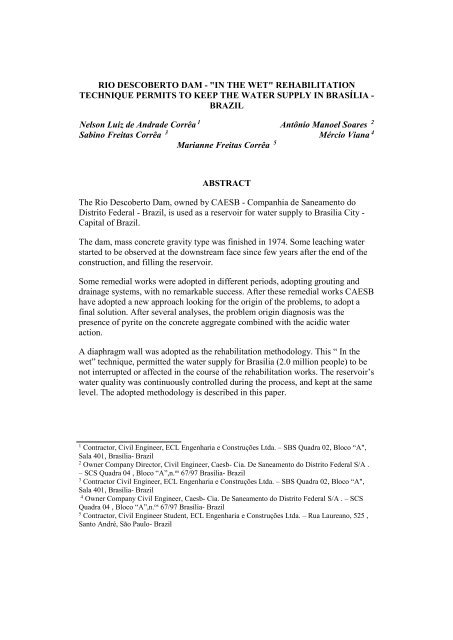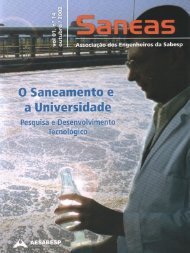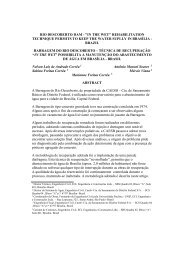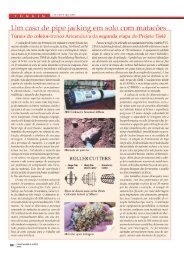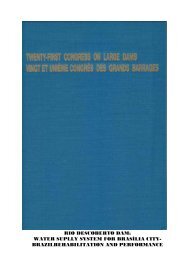USSD Rio Descoberto Dam - Sabino Freitas Correa-ENGL -
22nd US Society of Dams International Meeting Published - Rio Descoberto Dam - Rehabilitation Technique Permits to Keep Water Supply in Brasília - Brazil - Corrêa, Nelson, Corrêa Marianne, Sabino Freitas Correa, Soares,A., Viana,M.
22nd US Society of Dams International Meeting Published - Rio Descoberto Dam - Rehabilitation Technique Permits to Keep Water Supply in Brasília - Brazil - Corrêa, Nelson, Corrêa Marianne, Sabino Freitas Correa, Soares,A., Viana,M.
You also want an ePaper? Increase the reach of your titles
YUMPU automatically turns print PDFs into web optimized ePapers that Google loves.
RIO DESCOBERTO DAM - "IN THE WET" REHABILITATION<br />
TECHNIQUE PERMITS TO KEEP THE WATER SUPPLY IN BRASÍLIA -<br />
BRAZIL<br />
Nelson Luiz de Andrade Corrêa 1 Antônio Manoel Soares 2<br />
<strong>Sabino</strong> <strong>Freitas</strong> Corrêa 3 Mércio Viana 4<br />
Marianne <strong>Freitas</strong> Corrêa 5<br />
ABSTRACT<br />
The <strong>Rio</strong> <strong>Descoberto</strong> <strong>Dam</strong>, owned by CAESB - Companhia de Saneamento do<br />
Distrito Federal - Brazil, is used as a reservoir for water supply to Brasilia City -<br />
Capital of Brazil.<br />
The dam, mass concrete gravity type was finished in 1974. Some leaching water<br />
started to be observed at the downstream face since few years after the end of the<br />
construction, and filling the reservoir.<br />
Some remedial works were adopted in different periods, adopting grouting and<br />
drainage systems, with no remarkable success. After these remedial works CAESB<br />
have adopted a new approach looking for the origin of the problems, to adopt a<br />
final solution. After several analyses, the problem origin diagnosis was the<br />
presence of pyrite on the concrete aggregate combined with the acidic water<br />
action.<br />
A diaphragm wall was adopted as the rehabilitation methodology. This “ In the<br />
wet” technique, permitted the water supply for Brasilia (2.0 million people) to be<br />
not interrupted or affected in the course of the rehabilitation works. The reservoir’s<br />
water quality was continuously controlled during the process, and kept at the same<br />
level. The adopted methodology is described in this paper.<br />
1<br />
Contractor, Civil Engineer, ECL Engenharia e Construções Ltda. – SBS Quadra 02, Bloco “A",<br />
Sala 401, Brasília- Brazil<br />
2<br />
Owner Company Director, Civil Engineer, Caesb- Cia. De Saneamento do Distrito Federal S/A .<br />
– SCS Quadra 04 , Bloco “A”,n. os 67/97 Brasília- Brazil<br />
3<br />
Contractor Civil Engineer, ECL Engenharia e Construções Ltda. – SBS Quadra 02, Bloco “A",<br />
Sala 401, Brasília- Brazil<br />
4<br />
Owner Company Civil Engineer, Caesb- Cia. De Saneamento do Distrito Federal S/A . – SCS<br />
Quadra 04 , Bloco “A”,n. os 67/97 Brasília- Brazil<br />
5<br />
Contractor, Civil Engineer Student, ECL Engenharia e Construções Ltda. – Rua Laureano, 525 ,<br />
Santo André, São Paulo- Brazil
INTRODUCTION - PROBLEM PRESENTATION<br />
General <strong>Dam</strong> Construction Data<br />
PROBLEM PRESENTATION<br />
The <strong>Rio</strong> <strong>Descoberto</strong> <strong>Dam</strong> is located at 50 Km west from Brasília City`s<br />
downtown, and can be accessed by the BR-070 state asphalted road. The dam is<br />
used as a reservoir for Brazil´s Capital (Brasília City) water supply. The spillway<br />
stet capacity is 102,900,000 cubic meters, and approximately 60% of the local<br />
population water consummation is supplied by the <strong>Descoberto</strong> reservoir, serving<br />
up to 1,200,000 people. The dam is concrete gravity mass type with 54,500 cubic<br />
meters total concrete body mass. The typical section is trapezoidal with a top<br />
elongation, 3 meter crest width, 33 meter maximum height and 265 meter length<br />
(see cross section at fig. 4b.).<br />
The <strong>Rio</strong> <strong>Descoberto</strong> <strong>Dam</strong>´s body can be divided in three main parts, the 125 meter<br />
length left abutment, 85 meter length right abutment and the 55 meter length<br />
central spillway (see pic. 01 below). The spillway is “Creager” type with a type II<br />
USBR stilling basin. The construction was performed by blocks, separated by<br />
contraction joints, between the years of 1971 and 1974. The blocks pouring<br />
sequence was intercalated. The contraction joints used were “O” type waterstop<br />
Fugenband. The dam is composed by 18 blocks, named “A” to “R”. All the<br />
blocks are 15 meter wide, with an exception of “A” (10 meter in width). The crest<br />
level is at 1,034 m and the spillway level is at 1,030 m.<br />
Figure 01 – <strong>Rio</strong> <strong>Descoberto</strong> <strong>Dam</strong> Plant (above) and upstream view
Opening Remarks<br />
The consequences of pyrite composed concrete aggregate was known by the<br />
<strong>Descoberto</strong> <strong>Dam</strong> designers by the time of construction, but the low experience at<br />
that time with those reactivity problems, allowed the use of a low level pyrite<br />
concrete aggregate in this construction work. Posterior happenings including the<br />
pathologies observed at this dam, and the Fonsagrada <strong>Dam</strong> collapse report from<br />
Spain, demonstrated however, that even very low pyrite levels on hydraulic<br />
structures concrete aggregate may cause serious problems. A few years after filling<br />
the reservoir, leakages started to be observed at the downstream block “I” face. In<br />
the end of the 70´s decade, some wide fissures started to be observed too. From<br />
that time, until the performance of this project in 2000, the water leakage increased<br />
strongly, becoming into long horizontal leaching surfaces across the dam section.<br />
Chronology<br />
From the first problems appearing until the full rehabilitation diaphragm works,<br />
started in 2000, three remedial interventions were performed, without remarkable<br />
success. Those interventions were based on epoxy and grout injections. The<br />
resume of this chronology is displayed at the figure 2, below:<br />
1 st . Intervention<br />
Figure 2, intervention chronology<br />
Since the mid 70´s decade leakages were observed at “I” block’s downstream<br />
face. In 1981, as usual in leakage dam treatment method, the first intervention was<br />
performed. The solution was based in epoxy injections applied from the<br />
downstream face.<br />
2 nd . Intervention<br />
Between 1989 October and 1990 July, the second intervention was performed.<br />
The works were guided by a preliminary diagnose report made in 1988, this report<br />
indicated concreting joints failures as the origin of the problem. Those works<br />
consisted in the combination of grout injection filling at the upstream face with
internal drainage holes near the downstream face. Right after the conclusion of<br />
those works dam appearance was very good, without leakages at the downstream<br />
face and only some weak moisture spots could be observed at the upstream<br />
inspection gallery’s walls. The inspection gallery was clear and the foundation<br />
drains of the dam were operating well. Unfortunately, only three years after the<br />
conclusion of those works, the dam structure was worse than it was before.<br />
3 rd Intervention<br />
In 1993 the <strong>Descoberto</strong> <strong>Dam</strong> was confronted with several serious problems that<br />
continued to get worse. More than just the leaching horizontal planes at the<br />
downstream “E”, “I”, “G” and “O” block’s face with significant flow, the fissure<br />
problem had also been increased. At the leaching blocks, new percolating<br />
horizontal planes were observed. The inspection tunnel was flooded and full of<br />
carted material from the rock bottom drains.<br />
During the course of this intervention CAESB decided to adopt a new approach in<br />
order to reach the cause of those chronic problems. At this time was constituted a<br />
Consultant Committee, formed by the Professor Victor de Mello, Eng. Francisco<br />
Andriolo and Eng. Walton Pacelli. The committee ordered the collection of<br />
samples of inner inspection gallery drains sediment, dam’s concrete, reservoir and<br />
drain water analyses. Those analyses indicated the presence of pyrite on the<br />
concrete aggregate and foundations. The combination of the presence of that<br />
mineral with the action of acidic (pure) water, was contributing for the<br />
degeneration of the concrete structure of the <strong>Descoberto</strong> <strong>Dam</strong>. The main<br />
pathologies observed were pyrite reactions. The best solution was to implant an<br />
upstream waterproof barrier, avoiding the contact between the reservoir water and<br />
the body of the dam.<br />
The injection works were suspended and a 4.2 meter long pilot drive of the<br />
diaphragm secant piles wall was built for testing and experience purposes.<br />
Situation Analysis<br />
OWNER CONDITIONS<br />
After those three interventions without successful results, now with a deeper<br />
research of the problem developed by the committee, CAESB decided to fully<br />
rehabilitate the <strong>Descoberto</strong> <strong>Dam</strong>. Starting from the conclusions of the committee,<br />
observing the increase of the structural problems, CAESB started to search<br />
alternatives for the dam rehabilitation in order to bid the best options.
Picture 1.a (left) and 1.b (right): A. Downstream face of “O” block damaged by aggregate reaction<br />
(Sept. 1999); B. Alkali-Aggregate reaction at the upstream _face of the insp. gallery (Sept. 1999)<br />
Basic Requirements<br />
Five basic requests were imposed by the owner at his search for rehabilitation<br />
techniques:<br />
1) The rehabilitation method must prevent the water access to the dam<br />
concrete body and foundations;<br />
2) The water supply must be fully maintained during the rehabilitation works;<br />
3) The water quality must be fully maintained during the rehabilitation works;<br />
4) The method efficiency must be able to be tested by sections during the<br />
performance of the rehabilitation works;<br />
5) Grouting based impermeabilization solutions wouldn’t be accepted.<br />
PROBABLE METHODS<br />
A – Alternative 1:<br />
Diaphragm Wall across the<br />
body and concrete and<br />
foundations contact<br />
B - Alternative 2 :<br />
Geocomposites applied<br />
by caisson<br />
C - Alternative 3 :<br />
Geocomposites applied<br />
with an upper cofferdam<br />
D - Alternative 4 :<br />
Geocomposites appllied<br />
combined with an<br />
underwater concrete mat<br />
Figure 3, illustration of rehabilitation methods previously choice alternatives: A. Secant pile<br />
diaphragm wall, performed from the crest, drilling sequences near of the upstream face reaching<br />
until 5m into the rock foundations; B. Geocomposite barrier applied at the upstream face of the
dam dried by caissons, the barrier would be applied from the maximum water level until the<br />
reservoir bottom; C. Geocomposite barrier applied at the dry upstream of the dam after the<br />
construction of a cofferdam; D. Geocomposite barrier underwater applied from the maximum water<br />
level until the reservoir bottom, combined with inferior face and foundation protection by<br />
waterproof concrete mat.<br />
After the definition of the owner conditions, four main rehabilitation methods were<br />
initially selected. One of these methods was based on the secant pile diaphragm wall<br />
experience from 1993 and the three remaining were solutions based in geocomposites<br />
barriers application, with some variations, as illustrated above.<br />
Adopted Method<br />
The alternatives of application by caissons and with the cofferdam were excluded<br />
(alternatives B and C, illustrated at picture 3 above). With those two excluded alternatives<br />
was impossible to guarantee that the water supply and quality would be fully preserved<br />
during the works and those alternatives didn’t contemplate the foundation treatment and<br />
protection. After this selection CAESB bid the diaphragm wall and the underwater<br />
application geocomposite barrier alternatives. The ECL Engineering Ltd. Contractor won<br />
the bid offering the method described by this paper. The cost of that option was very lower<br />
than the underwater application geocomposite barrier option.<br />
Process Concept<br />
The process concept is based on the insert of a waterproof secant pile diaphragm wall<br />
inside the body of the dam, 70 cm far from the upstream face. The diaphragm is performed<br />
from the dam crest without any interference with the reservoir water, need of water level<br />
drop or intake obstruction. The secant bores are performed in sequence by drilling<br />
equipment with the use of a special guiding template. A drilling sequence composes an up<br />
to 2.60m long panel. The minimum acceptable thickness of the diaphragm panels is 50mm.<br />
The minimum thickness mechanically tested and filmed by a VHS underwater system.<br />
After the conclusion of a panel, the drive is filled with underwater applied mortar. After<br />
the mortar filling of a panel, the last bore of the filled panel is drilled again and this bore<br />
starts the next sequence. During the drilling process the panels are always filled with water<br />
in order to have equal pressures between the panel and the reservoir.<br />
Figures 4.a (left) and 4.b (right): A. drilling sequence, B. transversal dam section with diaphragm insertion
First Evaluations<br />
Before the beginning of the diaphragm wall rehabilitation works, several additional tests,<br />
analyses, and stability calculations were performed. The scope included permeability,<br />
capillarity, compressive and shearing tests at samples of the pilot drive of the diaphragm<br />
drive built in 1993 collected with rotary drilling probe extractors. Shearing tests at<br />
samples extracted from the contact between the diaphragm mortar and the concrete of the<br />
dam were also performed, in order to check the adherence between those different<br />
materials. Additional stability calculations were done addressing the extreme hypothesis of<br />
break of the small dam’s body part between the diaphragm and the upstream face. Those<br />
calculations were done addressing to a CAESB concern about the aggressive soluble<br />
effects of the soft water of the reservoir, with very low solid suspensions, on the upper part<br />
of the dam that would stay in contact with the water. That concern was also dissipated by<br />
the evidence that even staying in contact with the water, that part has the reactive effects<br />
severely decreased after diaphragm insert as a consequence of the end of the reaction<br />
renovation and leaching. Laboratory tests were also conducted with the mortar mixture<br />
indicated by the project designers and performance tests simulating the sub-aquatics mortar<br />
application conditions order to verify the possibility of segregation.<br />
CONSTRUCTION<br />
The rehabilitation construction was performed by two main groups of activities, drilling<br />
teams and mortar underwater application team:<br />
Drilling<br />
The drilling activities were performed with drilling equipments using DTH (down the<br />
hole) hammers, guided by a special alignment template developed for this project. The<br />
drilling machinery had to be adapted specifically for the project in order to have the<br />
drilling equipment tower aligned at the diaphragm axis.<br />
The project included 70,000 meter of 152 mm and 165mm drilled bores in 18 months of<br />
working in two shifts. Midsize drilling equipment were used in the project (with weight<br />
between 6 and 11ton) At the peak of production the job site had five drilling machines<br />
working at the same time, four at the dam crest and one at the spillway top. The deepest<br />
hole reached 38 meter depth, at block “I”, and 22 meter was the average drilling depth of<br />
the project.<br />
Boring deviations caused by flexion were minimized by the use of 100mm masts. Several<br />
types of bits were tested at this project, the concave and drop center types must be<br />
remarked for their best performance and alignment. The guiding template was built<br />
machining heavy hot rolling steel pipe. The drilling sequence, illustrated above at Figure<br />
4.a, consisted of drilling a panel first bore that works as a guide for the next using the<br />
template. Moreover than guidance, the template is necessary avoid bores overlay.
Mortar Pouring<br />
The mortar filling was made underwater with tremie type tube. The work was done from<br />
the dam crest. The tremie tube was connected directly at the mortar pumping line. The<br />
mortar pumping was made from pumps positioned beside the drum mixer parking area at<br />
the abutments outside border. In occasions where the pumping distance was bigger than<br />
100 meters, two serial disposed pumps were used.<br />
Two operational problems had to be solved:<br />
The total mortar volume applied at the project was not enough to assure the viability of<br />
the installation of a mixing plant at the job site;<br />
The distance from the job site to the nearest local concrete mixing plant (approx. 60 Km)<br />
was too big, spending more than 50% of the mortar lifetime at the journey.<br />
Those problems were solved by the construction of a cement storage place and a dosage<br />
ramp. With those very simple devices, the dosage of cement and admixtures could to be<br />
done at the job site into drum mixers loaded with the specified amount of sand and water.<br />
This procedure of dosage at the job site ended the mortar lifetime problems and enhanced<br />
the quality control.<br />
REALIZED CONTROLS - WATER QUALITY CONTROL<br />
The water supply of Brasília City, by the <strong>Rio</strong> <strong>Descoberto</strong> Reservoir system is made from<br />
an inlet at the “H” block upstream face. The water is pumped thru a 48” welded steel sewer<br />
straight for a Water Treatment Plant approx. 5 Km farther. At the Water Treatment Plant<br />
inlet the turbidity, coloration and colliform rates at the water are continuously controlled.<br />
Those indexes were kept stable during the works. Samples of the reservoir water had also<br />
been collected during the project performance and analyzed, including the determination of<br />
solid particles in suspension rate. This rate was, in fact, very low, as normal in high<br />
altitudes. These analyses showed that the quality of the water was not affected by the<br />
construction works.<br />
Water Losses Flow Control<br />
PROCESS CONTROL<br />
Since the beginning of the works, the downstream face and inspection gallery water loss<br />
flows were controlled. At the downstream face were installed small wood made channels,<br />
discharging in a collect point. At the inspection tunnel the flow measurement was made<br />
straight into the upstream pressure relief drains. The measurement was made by graduated<br />
containers and chronometers. During the job, the flow has been strongly decreased (99%).<br />
More flow control data can be found below at the Behavior Consideration subtitle.
Diaphragm Continuity<br />
The continuity of the diaphragm panels was controlled by mechanical testing and<br />
underwater VHS video system. The mechanical test was made by letting down a steel<br />
plate with the minimum diaphragm thickness allowed. This steel plate was hung by two<br />
ropes, and this procedure was hand made in order to assure the necessary sensitivity. In<br />
case of any kind of obstruction or discontinuity, the plate wouldn’t reach the bottom of the<br />
diaphragm panel. In case of persistence of doubt after the mechanical test, the VHS<br />
underwater camera was used to inspect the suspect drive. This video system was also used<br />
to check and register the contact between different drives.<br />
Mortar Control<br />
Besides the initial analyses done before starting the works, during the project all the mortar<br />
applied was controlled and tested. The controls were made by casting 10 cylindrical<br />
specimens at each truck mixer (6m3 capacity). From those ten specimens, four of them<br />
were experimented at compressive tests at 4-days age, four were tested at 28-days age and<br />
the two remaining were kept tagged with all the data concerning the mortar recorded. The<br />
average compressive strength was 27 MPa. There were also been made 3-day, 7-day, 28-<br />
day and 63-day age testing series.<br />
CONSTRUCTION CHRONOLOGY<br />
The drilling works started in September of 2000 at the block “Q”, this was the first block<br />
finished in 2001 January. The average drilling rate was 5000 meter per month, and the<br />
peak drilling month rate was reached in June of 2001 with 8000 meters drilled in 30 days,<br />
working with five drilling equipments.<br />
Comparative Photos<br />
Figure 5: Construction Chronogram<br />
BEHAVIOR EVALUATIONS
Pictures 2.a (left) and 2.b (right): A. block “O” in Sept. of 1999, block “O”, B. block “O” in Nov. of 2001<br />
after rehabilitation. Note: block “O” was the most damaged, and greatest downstream face water loss flow<br />
Comments and Conclusions<br />
Since the beggining of the rehabilitation of the <strong>Rio</strong> <strong>Descoberto</strong> <strong>Dam</strong>, the water losses are<br />
being measured and at the blocks concluded until 2002 January (all of them with exception<br />
of the “I” block), the loss flow have decreased from 34 l/s to 0.3 l/s. The last block under<br />
rehabilitation work in 2002 January, the “I” block, had the flow reduced from 15 l/s to<br />
2.0l/s with only 80% of this block diaphragm wall concluded at this time. The first blocks<br />
concluded in January and February of 2000, the “Q” and “C” blocks, had no maintanance<br />
since that and remained with the same initial eficiency.<br />
The method attempted to all of the technical requests presented by the Owner, CAESB,<br />
preserving the reservoirs water quality and keeping the CAESB capabity of water supply<br />
along the course of the works, without any kind of problems or disturbance for Brazil´s<br />
Capital habitants.<br />
REFERENCES<br />
- “Sistema de Recuperação do Maciço da Barragem do <strong>Rio</strong> <strong>Descoberto</strong>”, <strong>Correa</strong>,<br />
Marianne, Eng., Monograph tutored by Campolina, Antonio Moreira, Prof. Eng., Brasilia<br />
University, Brasilia, Brazil, 05/2001, UnB.<br />
-“Relatorio Consolidado de Obras”, Kffuri, Marcos, Eng., Potiguara, Magno, Eng., ECL<br />
Engenharia e Construçoes Ltda., Brasilia, Brazil, 11/2001, Caesb.<br />
-“Visit and Technical Recommendations for the <strong>Rio</strong> <strong>Descoberto</strong> <strong>Dam</strong>”, Committee,<br />
Mello, Victor F.B., Prof. Dr. PhD, Andriolo, Francisco, Eng., Paceli, Walton, Eng.,<br />
Brasília, Brazil, 12/1999,Caesb.<br />
-“ Ensaios com Testemunhos de Argamassa e Concreto”, Pacelli, Walton ,<br />
Eng.Bittencourt, Rubens M., Eng., Albuquerquem Albéria Cavalcanti, Eng. MSc.,<br />
Laboratório de Furnas, Goiania, Brazil, 06/2001, Caesb.<br />
- “Estudo da influência da Pirita nos agregados calcareous para a Barragem do <strong>Rio</strong><br />
<strong>Descoberto</strong>”, Petrucci, Eladio Eng., Basílio, Francisco Assis, Geotécnica , Brasília, Brasil,<br />
12/1972, Caesb.<br />
-“Análise de amostras da Barragem do <strong>Rio</strong> <strong>Descoberto</strong>”, Sigolo, Prof. Dr.; Assumção,<br />
J.C.B, Geologist, São Paulo, Brazil, 02/1995 Caesb.<br />
- “Relatório referente a análise de sedimentos G (Galeria) e R (Reservatório) visando<br />
caracterização mineral”, Sigolo, Prof. Dr.; Assumção, J.C.B, Geologist, São Paulo, Brazil,<br />
06/1993, Caesb .


